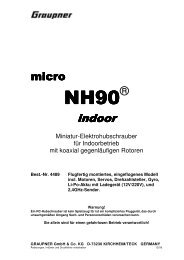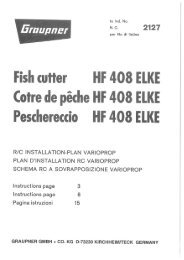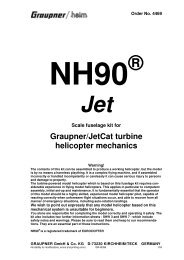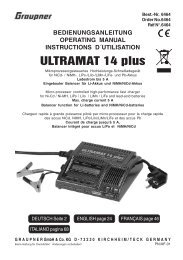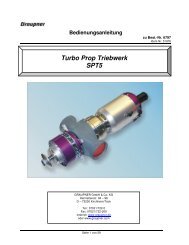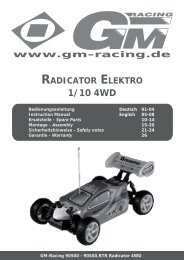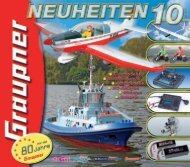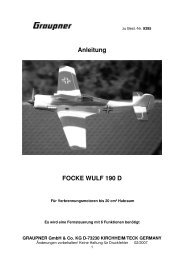0060427 Bauanleitung Alpina 2501 E_in E - Graupner
0060427 Bauanleitung Alpina 2501 E_in E - Graupner
0060427 Bauanleitung Alpina 2501 E_in E - Graupner
Create successful ePaper yourself
Turn your PDF publications into a flip-book with our unique Google optimized e-Paper software.
MANUAL<br />
<strong>Graupner</strong> GmbH & Co. KG * Henriettenstraße 94-96 * D- 73230 Kirchheim/Teck * www.graupner.de
Contents:<br />
2<br />
ALPINA <strong>2501</strong> ELEKTRO - High Performance Model Glider.....................3<br />
Preface. ........................................................................................................................3<br />
Kit Contents. ..............................................................................................................4<br />
Technical Data. ..........................................................................................................4<br />
RC functions. .............................................................................................................4<br />
Assembl<strong>in</strong>g your ALPINA <strong>2501</strong> ELEKTRO. ...................................................5<br />
The Fuselage and Empennage. ..................................................................................5<br />
Fuselage Open<strong>in</strong>gs / W<strong>in</strong>g far<strong>in</strong>g. .............................................................................5<br />
Compression Struts ....................................................................................................5<br />
Install<strong>in</strong>g the w<strong>in</strong>ch hook (if required) ......................................................................6<br />
Complet<strong>in</strong>g the canopy. .............................................................................................6<br />
Install<strong>in</strong>g the canopy catch.........................................................................................6<br />
Install<strong>in</strong>g the all-fly<strong>in</strong>g tail plane...............................................................................7<br />
Complet<strong>in</strong>g the tail-plane halves. ..............................................................................7<br />
Vertical stabiliser and rudder.....................................................................................8<br />
Rudder control horn. ..................................................................................................8<br />
Motor <strong>in</strong>stallation.......................................................................................................9<br />
Install<strong>in</strong>g the battery & servo frame ..........................................................................9<br />
Install the rudder & elevator Servos. .......................................................................10<br />
The W<strong>in</strong>gs................................................................................................................10<br />
W<strong>in</strong>g Jo<strong>in</strong>er..............................................................................................................10<br />
Installation of the w<strong>in</strong>g <strong>in</strong>cidence p<strong>in</strong>s ....................................................................10<br />
Install<strong>in</strong>g the Nylon w<strong>in</strong>g locks. ..............................................................................11<br />
Installation of the w<strong>in</strong>g servos. ................................................................................11<br />
Installation of the w<strong>in</strong>g control horns. .....................................................................12<br />
W<strong>in</strong>g servos wir<strong>in</strong>g..................................................................................................12<br />
F<strong>in</strong>ish<strong>in</strong>g....................................................................................................................13<br />
Radio Control Equipment Installation...............................................................13<br />
Balanc<strong>in</strong>g & Adjust<strong>in</strong>g..........................................................................................14<br />
Recommended control throws. ................................................................................14<br />
First Flights. .................................................................................................................15<br />
Safety. ..........................................................................................................................16<br />
Parts List....................................................................................................................18<br />
Pictures .....................................................................................................................19<br />
<strong>Graupner</strong> GmbH & Co. KG * Henriettenstraße 94-96 * D- 73230 Kirchheim/Teck * www.graupner.de
ALPINA <strong>2501</strong> ELEKTRO - High Performance Model Glider.<br />
<strong>Alp<strong>in</strong>a</strong> <strong>2501</strong> ELEKTRO ARC # 40000<br />
<strong>Alp<strong>in</strong>a</strong> <strong>2501</strong> ELEKTRO ARF # 40030<br />
<strong>Alp<strong>in</strong>a</strong> <strong>2501</strong> ELEKTRO Design Standard # 40015<br />
<strong>Alp<strong>in</strong>a</strong> <strong>2501</strong> ELEKTRO Design Mess<strong>in</strong>e # 40010<br />
Preface.<br />
3<br />
Thank you for choos<strong>in</strong>g the ALPINA <strong>2501</strong> ELEKTRO high performance electric<br />
glider. We wish you much success and enjoyment with your new model.<br />
Your TANGENT model kit from the home of GRAUPNER represents a mature design<br />
and the product of many years experience <strong>in</strong> the manufactur<strong>in</strong>g of high performance<br />
model aircraft. However, despite the most scrupulous quality control, small deviations<br />
may arise. We ask therefore that all parts be carefully <strong>in</strong>spected prior to undertak<strong>in</strong>g<br />
any assembly work and before fly<strong>in</strong>g the model. This is particularly important as any<br />
used parts are not subject to repair or replacement. Notwithstand<strong>in</strong>g the above, we<br />
are happy to repair or replace parts found to be faulty – subject to approval by the<br />
factory. Please therefore return any faulty parts together with a detailed description of<br />
the fault.<br />
Our products are the subject of cont<strong>in</strong>uous development and as such we reserve the<br />
right to make changes to the design, eng<strong>in</strong>eer<strong>in</strong>g, manufacture and materials<br />
supplied without prior notice. As the product is supplied <strong>in</strong> kit form, no claims will be<br />
considered <strong>in</strong> respect of the assembly or operation of the model.<br />
Caution!<br />
Remote controlled models and model aircraft <strong>in</strong> particular, are not toys <strong>in</strong> the<br />
normal sense. Build<strong>in</strong>g and operation of this model aircraft requires a high<br />
degree of technical understand<strong>in</strong>g and care, as well as considerable skill and<br />
discipl<strong>in</strong>e at the fly<strong>in</strong>g field. Errors <strong>in</strong> the build<strong>in</strong>g process and <strong>in</strong> the operation<br />
of this product can result <strong>in</strong> serious personal <strong>in</strong>jury and damage to property.<br />
As kit manufacturer we have no control over the assembly, ma<strong>in</strong>tenance and<br />
operation of this model aircraft, we therefore take this opportunity to stress the<br />
potential hazards and emphasise the personal responsibility on the part of the<br />
user.<br />
<strong>Graupner</strong> GmbH & Co. KG * Henriettenstraße 94-96 * D- 73230 Kirchheim/Teck * www.graupner.de
Kit Contents.<br />
(See Detailed Parts List)<br />
4<br />
1 Pair ARC W<strong>in</strong>gs - with elliptical tips, INTRO-Technik, torsion-rigid and fully<br />
<strong>in</strong>tegrated Ailerons and Flaps <strong>in</strong>corporat<strong>in</strong>g Elastik Flap Technology. TA-<br />
Servolocks and steel w<strong>in</strong>g-jo<strong>in</strong>er.<br />
1 Fuselage – <strong>in</strong> brilliant white, with <strong>in</strong>tegrated Bowden cables and pre-<strong>in</strong>stalled<br />
elevator bell-crank.<br />
1 Canopy - Pre-formed Carbon.<br />
1 Pair Tail-plane with <strong>in</strong>tegrated jo<strong>in</strong>er system, f<strong>in</strong>ished lead<strong>in</strong>g and trail<strong>in</strong>g edges.<br />
1 Rudder <strong>in</strong> preformed Balsa<br />
1 Set pre-formed wooden parts.<br />
1 Quality hardware accessory pack.<br />
1 Set wire parts.<br />
1 Set Build<strong>in</strong>g Instructions.<br />
Technical Data.<br />
W<strong>in</strong>gspan (mm).......................................................................................................<strong>2501</strong><br />
Fuselage length (mm) .............................................................................................1070<br />
W<strong>in</strong>g area (FAI) (dm 2 ).................................................................................................32,1<br />
Weight (gm). ............................................... ...................................................from 1450<br />
W<strong>in</strong>g load<strong>in</strong>g (FAI) (g/dm 2 ) ...............................................................................from 43,2<br />
Aerofoil ............................................................................................................... TA-029 Strak<br />
Horizontal dihedral (deg) ....................................................................................... circa1,3<br />
Centre of Gravity (mm - from root lead<strong>in</strong>g edge) ........................................................60-65<br />
RC functions.<br />
Ailerons 2 DS 3288 (Grp # 5187)<br />
Flaps 2 DS 3288 (Grp # 5187)<br />
Rudder 1 C 341 (Grp # 4093)<br />
Elevator 1 C 341 (Grp # 4093)<br />
Note: It is important that the Receiver Battery be selected to match the <strong>in</strong>tended use.<br />
The capacity ought to be sufficiently generous to cope with the on board radio control<br />
system (it’s always more useful to have more battery capacity than lead noseweight!).<br />
Consider<strong>in</strong>g the use of up to 6 servos, we recommend a battery pack of at<br />
least 1400 mAhr capacity (C ) and of good quality and always well ma<strong>in</strong>ta<strong>in</strong>ed.<br />
For a powered glider we recommend the follow<strong>in</strong>g a tried and tested drive<br />
configuration:<br />
Motor: Compact 460Z 11,1 V (Grp. #7748)<br />
Sp<strong>in</strong>ner: Precision Sp<strong>in</strong>ner (Grp. #6040.4)<br />
Propeller: Fold<strong>in</strong>g Carbon Fibre (Grp. #1336.33.18)<br />
Speed Controller: Brushless Speed Controller 60A (Grp. #7236)<br />
Battery: LiPo Battery 3/2600 mAhr (Grp. #7652.3G2)<br />
<strong>Graupner</strong> GmbH & Co. KG * Henriettenstraße 94-96 * D- 73230 Kirchheim/Teck * www.graupner.de
Important Note regard<strong>in</strong>g Styrofoam w<strong>in</strong>g cores.<br />
5<br />
For all jo<strong>in</strong>ts <strong>in</strong>volv<strong>in</strong>g Styrofoam w<strong>in</strong>g cores it is essential that you do not use<br />
any solvent based adhesives, and <strong>in</strong> particular avoid use of any form of cyanoacrylate<br />
glue. Use of such adhesives will destroy the foam and render the<br />
affected parts useless. Use only solvent-free adhesives, such as Epoxy res<strong>in</strong><br />
and/or Aliphatic Res<strong>in</strong> (white wood glue) if work<strong>in</strong>g anywhere near exposed<br />
areas of Styrofoam.<br />
Notes regard<strong>in</strong>g the use of Epoxy Res<strong>in</strong>.<br />
Epoxy alone is not a viable adhesive! However, the addition of appropriate additives<br />
makes for a variety of excellent adhesives. Match the choice of additive to the job at<br />
hand:<br />
1. Chopped cotton fibres – produces a tough but flexible jo<strong>in</strong>t.<br />
2. Superf<strong>in</strong>e glass fibres - makes a hard jo<strong>in</strong>t.<br />
3. Microballoons – produces a highly effective, lightweight filler.<br />
Assembl<strong>in</strong>g your ALPINA <strong>2501</strong> ELEKTRO.<br />
The kit you have purchased <strong>in</strong>cludes all the parts required to complete the basic<br />
airframe (ARC) and cover<strong>in</strong>g (ARF), but does not <strong>in</strong>clude adhesives or radio control<br />
components. You can make a significant contribution towards the ultimate<br />
appearance and performance of your model by build<strong>in</strong>g carefully and accurately. It is<br />
a well known fact that a poorly built model does not fly well and may be difficult to<br />
control. A well built and properly trimmed model will reward the pilot and spectators<br />
with good performance and accurate handl<strong>in</strong>g characteristics. Be patient, take your<br />
time; the effort will be well worth while!<br />
The Fuselage and Empennage.<br />
Beg<strong>in</strong> the construction with the Fuselage as this is the po<strong>in</strong>t of reference for all other<br />
parts.<br />
Fuselage Open<strong>in</strong>gs / W<strong>in</strong>g far<strong>in</strong>g.<br />
Open out all of the open<strong>in</strong>gs <strong>in</strong> the fuselage. Use a 2 mm dia. drill to make a series of<br />
small adjacent holes to prepare the open<strong>in</strong>gs <strong>in</strong> the <strong>in</strong> the area of the w<strong>in</strong>g fair<strong>in</strong>g.<br />
F<strong>in</strong>ish the open<strong>in</strong>gs us<strong>in</strong>g a small file as <strong>in</strong>dicated by the mark<strong>in</strong>gs <strong>in</strong> the mould.<br />
Tip. Use a needle file or suitable rotary tool to f<strong>in</strong>ish the job.<br />
Compression Struts<br />
Two compression struts are <strong>in</strong>stalled <strong>in</strong>side the fuselage, between the w<strong>in</strong>g roots at<br />
both lead<strong>in</strong>g and trail<strong>in</strong>g edge positions to prevent damage to the fuselage when the<br />
w<strong>in</strong>gs sw<strong>in</strong>g forward follow<strong>in</strong>g a heavy land<strong>in</strong>g. The front strut is located <strong>in</strong> front of<br />
the Multilock connector and the rear strut is located just beh<strong>in</strong>d the trail<strong>in</strong>g edge w<strong>in</strong>g<br />
<strong>in</strong>cidence p<strong>in</strong>s. Take care that the struts do not distort the shape of the fuselage.<br />
Check by temporarily <strong>in</strong>stall<strong>in</strong>g the w<strong>in</strong>gs and adjust the length of the struts to<br />
achieve a snug fit between the fuselage sides. Note that once <strong>in</strong>stalled, the front<br />
compression strut will restrict access to the fuselage open<strong>in</strong>g, so you may wish to<br />
<strong>Graupner</strong> GmbH & Co. KG * Henriettenstraße 94-96 * D- 73230 Kirchheim/Teck * www.graupner.de
6<br />
wait until the electrical connections to the w<strong>in</strong>g servos have been <strong>in</strong>stalled before<br />
f<strong>in</strong>ally <strong>in</strong>stall<strong>in</strong>g the front strut. The two struts are bonded <strong>in</strong> us<strong>in</strong>g suitably thickened<br />
epoxy.<br />
Fig. 1 Fuselage Compression Struts<br />
Install<strong>in</strong>g the w<strong>in</strong>ch hook (if required)<br />
Us<strong>in</strong>g a flexible tape-measure, measure and mark a po<strong>in</strong>t 300 mm from the nose<br />
along the underside of the fuselage. Drill a 2 mm hole to accommodate the w<strong>in</strong>ch<br />
hook. Cover the hole on the outside with tape to protect the surface and roughen up<br />
the <strong>in</strong>side of the fuselage <strong>in</strong> the area of the hole. Now glue the w<strong>in</strong>ch hook support<br />
block <strong>in</strong>to place centrally over the hole us<strong>in</strong>g thickened epoxy. Use the self tapp<strong>in</strong>g<br />
screw, through the hole <strong>in</strong> the bottom of the fuselage to secure the support block<br />
while the epoxy cures. Once cured, drill a 2mm hole <strong>in</strong> the support block to<br />
accommodate the w<strong>in</strong>ch hook.<br />
Tip: for additional security, you may wish to f<strong>in</strong>ish the job by lam<strong>in</strong>at<strong>in</strong>g the support<br />
block to the fuselage bottom us<strong>in</strong>g 2-3 layers of suitably wetted 120g fibreglass<br />
lam<strong>in</strong>at<strong>in</strong>g cloth.<br />
Catapult launch hook (if required)<br />
Some may wish to <strong>in</strong>stall a launch hook further forward <strong>in</strong> the nose for use with<br />
alternative launch methods such as from a catapult. In this case follow the same<br />
procedure as above, but we would recommend a position 100mm from the nose.<br />
Complet<strong>in</strong>g the canopy.<br />
The Carbon canopy is supplied ready made, requir<strong>in</strong>g only m<strong>in</strong>imal f<strong>in</strong>ish<strong>in</strong>g. Place<br />
the canopy on the fuselage open<strong>in</strong>g, carefully check the jo<strong>in</strong>t and adjust as<br />
necessary for a perfect fit. M<strong>in</strong>imum gap and good overall appearance will be your<br />
just reward for a little extra time and effort at this stage.<br />
Install<strong>in</strong>g the canopy catch.<br />
The forward canopy p<strong>in</strong> is held <strong>in</strong> place by the channelled hardwood support. The<br />
support is glued to the <strong>in</strong>side of the canopy at a position such that the tip of the p<strong>in</strong> is<br />
about 1mm <strong>in</strong>side the edge of the canopy – as shown. The canopy p<strong>in</strong> is likewise<br />
glued <strong>in</strong>to the channel <strong>in</strong> the hardwood support – such that the p<strong>in</strong> protrudes<br />
sufficiently from the front of the support to engage with the rim of the fuselage<br />
open<strong>in</strong>g. Re-check and adjust as necessary to achieve a good fit. Be sure to roughen<br />
the <strong>in</strong>side of the canopy with abrasive paper before glu<strong>in</strong>g to ensure a good bond.<br />
Once cured, test fit the canopy, and use a 3mm drill or suitable round file to form a<br />
recess <strong>in</strong> the forward rim of the fuselage open<strong>in</strong>g to accommodate the canopy p<strong>in</strong>.<br />
The rearward canopy fix<strong>in</strong>g is made us<strong>in</strong>g a U-shaped Steel spr<strong>in</strong>g fashioned from<br />
the supplied length of piano wire. The open ends of spr<strong>in</strong>g are glued between the two<br />
wooden strips such that the closed end of the spr<strong>in</strong>g protrudes about 2mm beyond<br />
the rear edge of the canopy – as shown. Once set <strong>in</strong> place, cover the support<strong>in</strong>g<br />
strips hold<strong>in</strong>g the spr<strong>in</strong>g with 1 -2 layers of fibre-glass cloth treated with a suitable<br />
res<strong>in</strong> to ensure a strong bond with the <strong>in</strong>side of the canopy. Aga<strong>in</strong>, be sure to<br />
<strong>Graupner</strong> GmbH & Co. KG * Henriettenstraße 94-96 * D- 73230 Kirchheim/Teck * www.graupner.de
7<br />
roughen up the <strong>in</strong>side of the canopy with abrasive paper before bond<strong>in</strong>g the spr<strong>in</strong>g <strong>in</strong><br />
place.<br />
Tip. Work carefully and accurately. Your patience will be rewarded by a tight fitt<strong>in</strong>g<br />
canopy!<br />
Fig 2. Canopy Catch<br />
Install<strong>in</strong>g the all-fly<strong>in</strong>g tail plane.<br />
The elevator bell-crank has been loosely <strong>in</strong>stalled at the factory but rema<strong>in</strong>s to be<br />
permanently bonded <strong>in</strong>to the f<strong>in</strong>. This system has proved entirely effective <strong>in</strong> many of<br />
our models over a long period of time and ensures a secure connection with no<br />
unwanted slop <strong>in</strong> the control system.<br />
Proceed as follows:<br />
• Open the holes <strong>in</strong> the f<strong>in</strong> us<strong>in</strong>g a twist drill.<br />
• Prepare the steel wires for the elevator jo<strong>in</strong>er. These should be cut to length<br />
(if necessary) and rounded off at the ends.<br />
• Prepare a means to hold the fuselage with the f<strong>in</strong> at right angles to the work<br />
surface. Also prepare someth<strong>in</strong>g on which to support the two tail-plane halves<br />
at right-angles to the f<strong>in</strong> and at the correct height. (A few carefully selected<br />
books might well serve as an adequate jig for this purpose!)<br />
Attach the all-fly<strong>in</strong>g tail-plane mak<strong>in</strong>g sure that the rearward steel wire jo<strong>in</strong>er passes<br />
through the hole <strong>in</strong> the bell-crank <strong>in</strong>stalled the f<strong>in</strong>. Carefully check the alignment of<br />
the tail-plane halves with the f<strong>in</strong>. Now loosen the two Alum<strong>in</strong>ium nuts hold<strong>in</strong>g the bellcrank<br />
bear<strong>in</strong>g <strong>in</strong> place and make any adjustment necessary to ensure that that tailplane<br />
halves can be aligned at exactly 90° to the f<strong>in</strong>. Apply a little thickened epoxy to<br />
the <strong>in</strong>side of the two nuts and carefully tighten, constantly check<strong>in</strong>g that correct<br />
alignment between tail-plane and f<strong>in</strong> is ma<strong>in</strong>ta<strong>in</strong>ed at all times.<br />
Leave the entire tail-plane assembled <strong>in</strong> the jig described above until the adhesive<br />
has fully cured.<br />
Tip: While work<strong>in</strong>g with adhesives <strong>in</strong> this area apply th<strong>in</strong> parcel tape over the<br />
sides of the f<strong>in</strong> <strong>in</strong> the area of the bear<strong>in</strong>g and cut through the tape to expose<br />
the holes. This will ensure that any excess adhesive does not spoil the f<strong>in</strong>ish<br />
on the fuselage.<br />
Complet<strong>in</strong>g the tail-plane halves.<br />
Fig 3 & 4. Install<strong>in</strong>g the all-fly<strong>in</strong>g tail plane<br />
Work on the uncovered tail-plane panels is limited to f<strong>in</strong>ish<strong>in</strong>g the root outl<strong>in</strong>e to<br />
match the profile of the f<strong>in</strong>. The tail-plane halves are factory f<strong>in</strong>ished, but some may<br />
wish to achieve an even more accurate match by carefully work<strong>in</strong>g the root area<br />
us<strong>in</strong>g a f<strong>in</strong>e grade abrasive paper.<br />
Note: The jo<strong>in</strong>er tubes <strong>in</strong>stalled <strong>in</strong> the tail-plane halves <strong>in</strong>corporate the <strong>in</strong>tegrated<br />
All Mov<strong>in</strong>g Tail-Lock mechanism.<br />
<strong>Graupner</strong> GmbH & Co. KG * Henriettenstraße 94-96 * D- 73230 Kirchheim/Teck * www.graupner.de
8<br />
Before fitt<strong>in</strong>g the jo<strong>in</strong>ers <strong>in</strong>to the brass tubes for the first time, check that the<br />
wire jo<strong>in</strong>ers are perfectly straight and burr free. When press<strong>in</strong>g the tail-plane<br />
halves <strong>in</strong>to place, you will feel a mild mechanical resistance which is<br />
sufficient to hold the tail-plane halves securely <strong>in</strong>-place dur<strong>in</strong>g flight.<br />
Vertical stabiliser and rudder.<br />
The f<strong>in</strong> post has been bonded <strong>in</strong>to the trail<strong>in</strong>g edge of the f<strong>in</strong> at the factory and the<br />
rudder supplied <strong>in</strong> the kit requires only m<strong>in</strong>imal f<strong>in</strong>ish<strong>in</strong>g.<br />
Open-up the rudder push-rod shroud at the rear of the fuselage us<strong>in</strong>g an 8-10mm<br />
dia. round file or similar rotary tool.<br />
Note: Customers build<strong>in</strong>g the ARC version may wish to take this opportunity to<br />
adjust the profile of the lead<strong>in</strong>g edge of the rudder to match the trail<strong>in</strong>g edge of the<br />
f<strong>in</strong>.<br />
Us<strong>in</strong>g a small round file; form a small semi-circular recess at the top of the f<strong>in</strong> post to<br />
accommodate the lead<strong>in</strong>g edge of the rudder.<br />
Carefully measure and mark the position of the two h<strong>in</strong>ge po<strong>in</strong>ts located 20mm from<br />
the base of the rudder and 200mm apart along the lead<strong>in</strong>g edge of the rudder.<br />
Transfer the position of the two h<strong>in</strong>ge po<strong>in</strong>ts onto the f<strong>in</strong> post and drill a 3mm hole at<br />
each po<strong>in</strong>t to accommodate the supplied Nylon h<strong>in</strong>ges. Work carefully to determ<strong>in</strong>e<br />
the correct depth of the h<strong>in</strong>ge po<strong>in</strong>ts and to ensure equal and adequate rudder<br />
throws. Trial fit the rudder and the h<strong>in</strong>ges. Once satisfied with the position<strong>in</strong>g, glue<br />
the h<strong>in</strong>ges <strong>in</strong>to place <strong>in</strong> the f<strong>in</strong> post us<strong>in</strong>g thickened epoxy. In the same way, glue the<br />
protrud<strong>in</strong>g h<strong>in</strong>ge po<strong>in</strong>ts <strong>in</strong>to the lead<strong>in</strong>g edge of the rudder.<br />
Tip: Take care to avoid any epoxy f<strong>in</strong>d<strong>in</strong>g its way <strong>in</strong>to the h<strong>in</strong>ge mechanism. Apply<br />
a very small drop of oil (or suitable release agent) to the h<strong>in</strong>ge-p<strong>in</strong> and check<br />
periodically while the jo<strong>in</strong>t is cur<strong>in</strong>g. .<br />
Rudder control horn.<br />
Fig 5. Rudder H<strong>in</strong>ges<br />
Drill a 4mm hole <strong>in</strong> the base of the rudder to accommodate the eye-bolt which forms<br />
the rudder control horn. The hole is to be 6mm from the base and 9mm from the<br />
lead<strong>in</strong>g edge of the rudder. The hole <strong>in</strong> the eye-bolt is positioned centrally with<strong>in</strong> the<br />
rudder push-rod shroud and at 90° to the rudder itself.<br />
Drill carefully, without pierc<strong>in</strong>g the outer sk<strong>in</strong> of the rudder.<br />
Once satisfied, bond the eye-bolt securely <strong>in</strong>to the rudder us<strong>in</strong>g thickened epoxy<br />
leav<strong>in</strong>g a small bead of thickened epoxy around the base of the eye-bolt.<br />
Note: Customers build<strong>in</strong>g the ARC version may wish to cover the rudder before<br />
glu<strong>in</strong>g the eye-bolt <strong>in</strong> place.<br />
Customers build<strong>in</strong>g the ARF version will need to carefully remove a little of the<br />
cover<strong>in</strong>g material around the fix<strong>in</strong>g po<strong>in</strong>t.<br />
Fig 6 & 7. Rudder Control Horn<br />
<strong>Graupner</strong> GmbH & Co. KG * Henriettenstraße 94-96 * D- 73230 Kirchheim/Teck * www.graupner.de
Motor <strong>in</strong>stallation<br />
9<br />
Prepare the area where the motor mount is to be bonded to the <strong>in</strong>side of the fuselage<br />
nose with a course abrasive paper (80 Grit) to ensure a good bond. The motor mount<br />
should be <strong>in</strong>stalled about 1mm beh<strong>in</strong>d the edge of the fuselage nose.<br />
Tip: Fit a long nylon bolt through the centre hole <strong>in</strong> the motor mount and use<br />
the protrud<strong>in</strong>g part of the bolt as an aid to adjust<strong>in</strong>g the precise amount of<br />
down-thrust and side-thrust. The bolt also serves as a useful handle while<br />
position<strong>in</strong>g the motor-mount <strong>in</strong> place.<br />
With the motor temporally <strong>in</strong>stalled, fit the propeller yoke and sp<strong>in</strong>ner and check the<br />
alignment of the fuselage nose with the sp<strong>in</strong>ner. Carefully f<strong>in</strong>ish the front of the<br />
fuselage nose to match the profile of your chosen sp<strong>in</strong>ner.<br />
Now carefully position the motor mount <strong>in</strong> place and secure with a few drops of<br />
<strong>in</strong>stant adhesive before f<strong>in</strong>ally bond<strong>in</strong>g <strong>in</strong> place with a generous bead of suitably<br />
thickened epoxy to both sides of the motor mount.<br />
Note: Be sure to make provision for adequate air-<strong>in</strong>take to cool the drive<br />
system. Some customers may prefer to use a so called Turbo-Sp<strong>in</strong>ner which<br />
provides for <strong>in</strong>take of air through the sp<strong>in</strong>ner itself, but do make sure that<br />
adequate cool<strong>in</strong>g is provided.<br />
Only when the motor-mount is fully secure, re-<strong>in</strong>stall the motor (remember to use lock<br />
washers) and ensure that the drive shaft turns feely and there is adequate<br />
clearances for the propeller yoke and sp<strong>in</strong>ner assembly. A gap of about 1mm<br />
between the sp<strong>in</strong>ner and the fuselage nose is recommended. For the sake of safety,<br />
don’t <strong>in</strong>stall the propeller until the model is complete!<br />
Note: Check that the screws used to secure the motor to the motor mount are<br />
not too long as they may otherwise foul the <strong>in</strong>ternal motor mechanism. You<br />
may f<strong>in</strong>d it necessary to counters<strong>in</strong>k the mount<strong>in</strong>g screws slightly, to achieve<br />
clearance with the propeller yoke/sp<strong>in</strong>ner assembly.<br />
Install<strong>in</strong>g the battery & servo frame<br />
Select the battery & servo mount<strong>in</strong>g frame from the wooden parts set. The front of<br />
the mount<strong>in</strong>g frame is to be located about 140mm from the rear of the cockpit<br />
open<strong>in</strong>g. Make sure that there is sufficient space <strong>in</strong> front of the servo mount<strong>in</strong>g frame<br />
to accommodate your chosen battery pack and adjust to suit.<br />
Fig 8. Battery & Servo Frame<br />
Note: The mount<strong>in</strong>g frame does fit <strong>in</strong> the fuselage open<strong>in</strong>g! Turn it around carefully<br />
and you will f<strong>in</strong>d that it will slip neatly <strong>in</strong>to place. Don’t be tempted to sand away<br />
too much material which will result <strong>in</strong> a poor fit.<br />
Mark the position carefully with a pencil. Now remove the two protective strips from<br />
the <strong>in</strong>side of the fuselage open<strong>in</strong>g and tack the servo frame <strong>in</strong> place us<strong>in</strong>g an <strong>in</strong>stant<br />
<strong>Graupner</strong> GmbH & Co. KG * Henriettenstraße 94-96 * D- 73230 Kirchheim/Teck * www.graupner.de
10<br />
adhesive – before bond<strong>in</strong>g the frame securely <strong>in</strong>to the fuselage with a generous bead<br />
of thickened epoxy. Allow to cure.<br />
Tip: Some may wish to complete the job by add<strong>in</strong>g a layer of wetted fibre glass<br />
cloth over the entire servo frame allow<strong>in</strong>g about 10mm extra on both sides to bond<br />
with the fuselage sides.<br />
Install the rudder & elevator Servos.<br />
Fig 9. Battery & Servo Frame<br />
Test fit and <strong>in</strong>stall the rudder and elevator servos <strong>in</strong> the cut-outs <strong>in</strong> the servo<br />
mount<strong>in</strong>g frame accord<strong>in</strong>g to the <strong>in</strong>structions supplied with the servos. Cut the rudder<br />
and elevator l<strong>in</strong>kages to length and solder clevis adaptors securely to the wire ends<br />
hav<strong>in</strong>g first thoroughly cleaned and prepared the jo<strong>in</strong>t. Fit clevises and lock-nuts and<br />
adjust accord<strong>in</strong>gly such that the control surfaces are held at neutral when the servo<br />
positions are centred.<br />
Tip. Suitably thickened epoxy may also be used to fix the clevis adaptors to the<br />
control l<strong>in</strong>kages (as an alternative to solder). This method is more appropriate <strong>in</strong><br />
the case of glass fibre push rods. In either case it is good practice to apply a small<br />
piece of heat-shr<strong>in</strong>k tub<strong>in</strong>g over the jo<strong>in</strong>t.<br />
F<strong>in</strong>ally secure the Bowden cables to the <strong>in</strong>side of the fuselage side with a little<br />
suitably thickened epoxy to ensure slop free control l<strong>in</strong>kages.<br />
The W<strong>in</strong>gs<br />
The w<strong>in</strong>g panels are supplied largely complete and require only the m<strong>in</strong>imum of<br />
<strong>in</strong>stallation work and f<strong>in</strong>ish<strong>in</strong>g.<br />
W<strong>in</strong>g Jo<strong>in</strong>er<br />
The ALPINA <strong>2501</strong> ELEKTRO features a float<strong>in</strong>g jo<strong>in</strong>er, mean<strong>in</strong>g that the open<strong>in</strong>g is<br />
the fuselage is approx. 1 mm larger than the diameter of the w<strong>in</strong>g jo<strong>in</strong>er. This system<br />
is widely used <strong>in</strong> full-size aircraft and has been well proven over many years of model<br />
design and manufacture. The ma<strong>in</strong> w<strong>in</strong>g jo<strong>in</strong>er consists of a s<strong>in</strong>gle Ø 10 mm<br />
hardened steel w<strong>in</strong>g-jo<strong>in</strong>er which is ample to carry the flight loads. The fuselage is<br />
suspended between the w<strong>in</strong>g panels on four steel <strong>in</strong>cidence p<strong>in</strong>s – the comb<strong>in</strong>ed<br />
shear strength of which is more than one ton!<br />
Installation of the w<strong>in</strong>g <strong>in</strong>cidence p<strong>in</strong>s<br />
Work carefully when drill<strong>in</strong>g the holes <strong>in</strong> the w<strong>in</strong>g roots to accommodate the<br />
<strong>in</strong>cidence p<strong>in</strong>s as these determ<strong>in</strong>e the <strong>in</strong>cidence (with respect to the fuselage).<br />
Us<strong>in</strong>g small screw-clamps, carefully fix small 3mm thick pieces of scrap Balsa to the<br />
top and bottom surfaces of the w<strong>in</strong>g at both lead<strong>in</strong>g and trail<strong>in</strong>g edges. The upper<br />
pieces should be positioned to overhang the w<strong>in</strong>g root by a few millimetres - to act as<br />
guides along the fuselage w<strong>in</strong>g fair<strong>in</strong>g.<br />
Position one w<strong>in</strong>g panel carefully aga<strong>in</strong>st the fuselage fair<strong>in</strong>g at the lead<strong>in</strong>g and<br />
trail<strong>in</strong>g edge, us<strong>in</strong>g the small Balsa pieces as guides, and tape it firmly <strong>in</strong> place. Now<br />
mark the position of the holes for <strong>in</strong>cidence p<strong>in</strong>s on the w<strong>in</strong>g root by work<strong>in</strong>g through<br />
<strong>Graupner</strong> GmbH & Co. KG * Henriettenstraße 94-96 * D- 73230 Kirchheim/Teck * www.graupner.de
11<br />
the holes <strong>in</strong> the opposite side of the fuselage us<strong>in</strong>g a sharpened 3mm steel rod (or<br />
similar tool).<br />
Remove the w<strong>in</strong>g and drill the holes <strong>in</strong> the w<strong>in</strong>g root us<strong>in</strong>g a 3mm twist drill.<br />
Remember to take account of the w<strong>in</strong>g dihedral; the holes should be drilled parallel to<br />
the w<strong>in</strong>g jo<strong>in</strong>er. Once both w<strong>in</strong>gs have been marked and drilled, the four <strong>in</strong>cidence<br />
p<strong>in</strong>s can be bonded <strong>in</strong>to place us<strong>in</strong>g a slow sett<strong>in</strong>g thickened epoxy. Be sure to make<br />
one p<strong>in</strong> <strong>in</strong> each w<strong>in</strong>g a little longer than the other, and round off the end of the p<strong>in</strong>s to<br />
facilitate easier assembly at the fly<strong>in</strong>g field.<br />
Note! Apply a suitable release agent (floor wax works well) to the holes <strong>in</strong> the<br />
fuselage sides and to the fair<strong>in</strong>g itself before apply<strong>in</strong>g the adhesive, then fit the<br />
w<strong>in</strong>gs to the fuselage, with the steel jo<strong>in</strong>er <strong>in</strong>stalled to allow the epoxy to cure<br />
overnight.<br />
Install<strong>in</strong>g the Nylon w<strong>in</strong>g locks.<br />
Fig. 9. Float<strong>in</strong>g W<strong>in</strong>g Jo<strong>in</strong>er<br />
Note: Customers build<strong>in</strong>g the ARC version may prefer to wait until after the w<strong>in</strong>gs<br />
have been covered before complet<strong>in</strong>g this step.<br />
The supplied Nylon w<strong>in</strong>g locks are used to secure the w<strong>in</strong>g jo<strong>in</strong>ts. The sockets have<br />
already been <strong>in</strong>stalled <strong>in</strong> the fuselage w<strong>in</strong>g root. The match<strong>in</strong>g plugs are required to<br />
be glued <strong>in</strong>to the w<strong>in</strong>g roots to complete the jo<strong>in</strong>t.<br />
First check the plugs fit the holes provided <strong>in</strong> the w<strong>in</strong>g roots and adjust if necessary.<br />
Once the holes have been adequately prepared, glue the plugs <strong>in</strong>to the w<strong>in</strong>g roots<br />
and with the steel w<strong>in</strong>g jo<strong>in</strong>er <strong>in</strong>stalled, engage the w<strong>in</strong>gs firmly with the mat<strong>in</strong>g<br />
sockets and ensure correct alignment. Take due care when complet<strong>in</strong>g this step to<br />
avoid the effects of any excess epoxy.<br />
Tip. Cover the fuselage w<strong>in</strong>g roots with kitchen film (or similar material) to protect<br />
the surface and apply a releas<strong>in</strong>g agent to the locks themselves while the epoxy<br />
cures. Once cured, the w<strong>in</strong>g locks are easily separated by apply<strong>in</strong>g firm pressure,<br />
by hand, along the lead<strong>in</strong>g edge of the w<strong>in</strong>g.<br />
Installation of the w<strong>in</strong>g servos.<br />
The TA Servo LOCK system supplied with your ALPINA <strong>2501</strong>ELEKTRO kit provides<br />
a universal w<strong>in</strong>g servo mount<strong>in</strong>g mechanism which is both simple and very secure.<br />
Remove sufficient polystyrene to the <strong>in</strong>side the factory prepared servo-wells to<br />
accommodate your chosen servos up to the <strong>in</strong>side of the upper w<strong>in</strong>g sk<strong>in</strong>. Re<strong>in</strong>force<br />
the area of the upper w<strong>in</strong>g sk<strong>in</strong> with a small piece of 100 g./dm ² glass cloth and<br />
epoxy res<strong>in</strong>. This prevents stress po<strong>in</strong>ts <strong>in</strong> the upper w<strong>in</strong>g sk<strong>in</strong> as a result of <strong>in</strong>stall<strong>in</strong>g<br />
the servos. F<strong>in</strong>ally glue the plywood servo mount<strong>in</strong>g frames to servo open<strong>in</strong>gs <strong>in</strong> the<br />
w<strong>in</strong>gs.<br />
Note: In the case of the ARF version, the plywood servo frames are pre<strong>in</strong>stalled<br />
at the factory.<br />
The servos themselves are simply bonded to the <strong>in</strong>side of the servo cover scoop<br />
us<strong>in</strong>g suitably thickened epoxy and screwed onto the plywood frames (see also the<br />
<strong>Graupner</strong> GmbH & Co. KG * Henriettenstraße 94-96 * D- 73230 Kirchheim/Teck * www.graupner.de
12<br />
<strong>in</strong>stallation note supplied with the TA servo LOCK set). Be sure to roughen the<br />
surface of the servo cover to ensure a good bond.<br />
Tip: Protect the servos with heat shr<strong>in</strong>k sleeve. This makes for easy removal<br />
and replacement of the servo, but care should be taken so as not to overheat<br />
the servos while apply<strong>in</strong>g the sleeve.<br />
Installation of the w<strong>in</strong>g control horns.<br />
Note: ARF customers will need to remove a little of the cover<strong>in</strong>g material while<br />
those build<strong>in</strong>g the ARC version may prefer to wait until after the w<strong>in</strong>gs have been<br />
covered before bond<strong>in</strong>g the control horns <strong>in</strong> place.<br />
Ailerons: Mark out the position of the aileron control horns on the lower surface of the<br />
aileron. The horn should be positioned directly opposite the scoop <strong>in</strong> the servo cover<br />
and about 3 mm from the aileron lead<strong>in</strong>g edge.<br />
Drill a series of 2mm diameter holes and cut away the excess to form a neat slot to<br />
accommodate the supplied GRP control horns. Take care not to cut through to the<br />
upper surface of the aileron and undercut a little of the material <strong>in</strong>side the slot to<br />
allow for additional adhesive.<br />
Locate the aileron control horn such that the eye is at 90° to the h<strong>in</strong>ge l<strong>in</strong>e and about<br />
13mm above the lower surface of the aileron.<br />
Flaps: Similarly locate the slots to accommodate the supplied GRP control horns<br />
about 3mm beh<strong>in</strong>d the lead<strong>in</strong>g edge of the flap such that the eye is located about<br />
10mm beh<strong>in</strong>d the flap lead<strong>in</strong>g edge and about 12mm above the lower surface of the<br />
flap.<br />
Once satisfied with the position, bond the GRP control horns <strong>in</strong>to place us<strong>in</strong>g<br />
thickened epoxy and allow to cure.<br />
W<strong>in</strong>g servos wir<strong>in</strong>g.<br />
Fig 10 & 11. W<strong>in</strong>g Servo & Control Horns<br />
Prepare two cable harnesses to connect the w<strong>in</strong>g mounted aileron and flap servos to<br />
the receiver system. The connectors may be either fixed <strong>in</strong>to the w<strong>in</strong>g and fuselage<br />
w<strong>in</strong>g fair<strong>in</strong>g roots, or left on fly<strong>in</strong>g leads. However you choose to proceed, be sure to<br />
use good quality twisted servo leads, with a wire diameter of no less than 0.25 mm ²<br />
and polarised connectors, preferably with Gold contacts capable of deliver<strong>in</strong>g<br />
adequate current for the 4 w<strong>in</strong>g servos under load.<br />
Note: Quality cable sets, <strong>in</strong>clud<strong>in</strong>g connectors and separation filters are available<br />
via the specialist model trade; choose high quality components for optimum<br />
reliability. In the case where fly<strong>in</strong>g leads are used, take care always to handle the<br />
leads only by the connectors. Don’t pull on the leads!<br />
ARF customers should now move to <strong>in</strong>stallation of the radio control equipment while<br />
those build<strong>in</strong>g the ARC version should now beg<strong>in</strong> the f<strong>in</strong>ish<strong>in</strong>g stage.<br />
<strong>Graupner</strong> GmbH & Co. KG * Henriettenstraße 94-96 * D- 73230 Kirchheim/Teck * www.graupner.de
F<strong>in</strong>ish<strong>in</strong>g.<br />
13<br />
Film cover<strong>in</strong>g – all the wooden surfaces are supplied pre-sanded, but will benefit<br />
from further f<strong>in</strong>e f<strong>in</strong>ish<strong>in</strong>g prior to cover<strong>in</strong>g. Follow the <strong>in</strong>structions provided with the<br />
cover<strong>in</strong>g materials, always tak<strong>in</strong>g care to make all jo<strong>in</strong>s <strong>in</strong> the direction of the air-flow.<br />
As an alternative to our own high stable decorative v<strong>in</strong>yl based cover<strong>in</strong>g material, we<br />
can also recommend Oracover (Profilm) cover<strong>in</strong>g materials.<br />
NOTE: Take care to avoid excessive heat when us<strong>in</strong>g heat-shr<strong>in</strong>k cover<strong>in</strong>g films on<br />
the w<strong>in</strong>gs as the polystyrene cores will be destroyed (polystyrene starts to melt at<br />
70°C). Use low temperature heat-shr<strong>in</strong>k cover<strong>in</strong>g films and make every effort to avoid<br />
prolonged exposure to heat.<br />
Fibre-glass f<strong>in</strong>ish – for the ultimate f<strong>in</strong>ish to your ALPINA <strong>2501</strong> ELEKTRO, cover<br />
the w<strong>in</strong>gs and tail-plane with a lightweight glass-fibre cloth and treat with a suitable<br />
f<strong>in</strong>ish<strong>in</strong>g res<strong>in</strong>. This <strong>in</strong>volves a specialist process which is well documented <strong>in</strong> the<br />
popular model trade. Choose good quality materials and follow the manufacturer’s<br />
<strong>in</strong>structions. Take care not to add excessive weight!<br />
DESIGN Models.<br />
Our DESIGN range of models are supplied with pre-pr<strong>in</strong>ted graphics which are both<br />
lightweight and durable. Please observe the follow<strong>in</strong>g simple steps to ma<strong>in</strong>ta<strong>in</strong> the<br />
appearance:<br />
• TA-Film is stable up to a nom<strong>in</strong>al temperature of 70 0 C so care should be<br />
taken not to expose the surfaces to excess heat. The use of a normal<br />
hairdryer is all that is required to soften the material should it eventually<br />
become necessary.<br />
• The graphics are waterproof but are not resistant to solvents. Clean your<br />
model with a mild solution of soapy water applied with a soft sponge and dry<br />
carefully to restore the f<strong>in</strong>e f<strong>in</strong>ish.<br />
• Do not under any circumstances use clean<strong>in</strong>g products which conta<strong>in</strong><br />
concentrated alcohol or acetone as a solvent.<br />
Radio Control Equipment Installation.<br />
Fuselage servo <strong>in</strong>stallation - Install the servos <strong>in</strong> the servo mount<strong>in</strong>g tray, follow<strong>in</strong>g<br />
<strong>in</strong>structions supplied with your radio control equipment. Connect the servo output<br />
horns and clevises and check full and free movement – us<strong>in</strong>g the full range of the<br />
servo. Also check for any slop <strong>in</strong> the push-rods and secure the Bowden cable<br />
carriers always keep<strong>in</strong>g m<strong>in</strong>d to m<strong>in</strong>imise the length of unsupported control l<strong>in</strong>kage.<br />
Note: Depend<strong>in</strong>g on your choice of servos, you may f<strong>in</strong>d that you will have to<br />
remove a little material <strong>in</strong> the area of the fuselage open<strong>in</strong>g to accommodate the<br />
servo output horns. Do so carefully, remov<strong>in</strong>g only the m<strong>in</strong>imum amount of<br />
material necessary to <strong>in</strong>stall and operate the servos.<br />
<strong>Graupner</strong> GmbH & Co. KG * Henriettenstraße 94-96 * D- 73230 Kirchheim/Teck * www.graupner.de
14<br />
W<strong>in</strong>g servo <strong>in</strong>stallation - Ensure that the servo output arms are set at 90° with the<br />
servo electrically centred. Prepare the l<strong>in</strong>kages, us<strong>in</strong>g threaded rod, clevises and<br />
lock-nuts remember<strong>in</strong>g to apply a drop of thread-lock to the lock nuts or apply a short<br />
length of heat-shr<strong>in</strong>k over the jo<strong>in</strong>t.<br />
Secure the servo covers <strong>in</strong> place us<strong>in</strong>g the four small screws provided. Use a<br />
counters<strong>in</strong>k tool to recess the screw heads <strong>in</strong>to the servo covers to improve both the<br />
appearance and the aerodynamic performance.<br />
Receiver <strong>in</strong>stallation - The receiver is best <strong>in</strong>stalled to the rear of the fuselage<br />
cockpit open<strong>in</strong>g, a good quality Velcro Hook & Loop material is quite adequate for<br />
this purpose. The receiver antenna is ideally <strong>in</strong>serted <strong>in</strong>to a suitable antenna tube (or<br />
plastic Bowden cable carrier) and <strong>in</strong>serted down the length of the fuselage<br />
Although there is a certa<strong>in</strong> amount of Carbon used <strong>in</strong> the construction of the<br />
fuselage, we would suggest that there is no problem runn<strong>in</strong>g the antenna down the<br />
<strong>in</strong>side of the fuselage boom (we fly all our models this way). However, ALWAYS<br />
carry out a thorough range test before fly<strong>in</strong>g the model and if any doubt whatsoever<br />
then allow the antenna to hang freely.<br />
Tip: Never <strong>in</strong>stall the antenna taut, but allow some slack <strong>in</strong> the wire to allow for<br />
small movements with<strong>in</strong> the fuselage.<br />
The model is now largely complete, but some very important work rema<strong>in</strong>s to be<br />
done while still <strong>in</strong> the workshop.<br />
Balanc<strong>in</strong>g & Adjust<strong>in</strong>g.<br />
The correct centre of gravity and longitud<strong>in</strong>al dihedral are first determ<strong>in</strong>ed<br />
theoretically, and then confirmed <strong>in</strong> practice by test fly<strong>in</strong>g model.<br />
A successful first test flight is <strong>in</strong>variably a matter of good preparation!<br />
Centre of gravity and longitud<strong>in</strong>al dihedral.<br />
Start with the centre of gravity between 60 and 65 mm beh<strong>in</strong>d the root w<strong>in</strong>g lead<strong>in</strong>g<br />
edge – this has been found to be ideal <strong>in</strong> test flights. You ought to be able to achieve<br />
the required balance po<strong>in</strong>t by careful location of the flight battery. Be sure all<br />
batteries are secure as any movement whilst <strong>in</strong> flight will impact the correct centre of<br />
gravity and adversely affect the proper fly<strong>in</strong>g characteristics of the model.<br />
The correct longitud<strong>in</strong>al dihedral (decelage) is +1.3°. This is the angle of the elevator<br />
(at the neutral position) with respect to the w<strong>in</strong>g and is best measured us<strong>in</strong>g an<br />
<strong>in</strong>cidence meter.<br />
Recommended control throws.<br />
The follow<strong>in</strong>g recommended control throws have been determ<strong>in</strong>ed follow<strong>in</strong>g several<br />
test flights, confirmed by several different model pilots. We strongly recommend that<br />
you beg<strong>in</strong> with the recommended throws and only change them with experience.<br />
<strong>Graupner</strong> GmbH & Co. KG * Henriettenstraße 94-96 * D- 73230 Kirchheim/Teck * www.graupner.de
The throws are measured at the po<strong>in</strong>t of maximum deflection – <strong>in</strong> millimetres:<br />
Normal Flight<br />
Up Down Left/Right<br />
Rudder 30 / 30<br />
Elevator 9 9<br />
Ailerons 10 5<br />
Flaps 0 0<br />
15<br />
We recommend about 20% exponential <strong>in</strong> the elevator channel. The flaps may be set<br />
to move upwards, half the travel of the ailerons for full control of the trail<strong>in</strong>g edge<br />
Thermal Sett<strong>in</strong>g<br />
Up Down<br />
Ailerons (Camber) 1,5<br />
Flaps (Camber) 1,5<br />
The flaps should not move with the ailerons, but some model pilots prefer to mix the<br />
flaps with elevator (Snap-Flap) <strong>in</strong> this mode.<br />
Speed Sett<strong>in</strong>g<br />
Up Down<br />
Aileron (Reflex) 1,5<br />
Flap (Reflex) 1,5<br />
In this mode the flaps may be set to move both up and down, about half the travel of<br />
the ailerons.<br />
Land<strong>in</strong>g Sett<strong>in</strong>g<br />
Up Down Comment<br />
Flaps 20 Butterfly<br />
Aileron 8 Butterfly<br />
Elevator 40% Reach<br />
Your ALPINA <strong>2501</strong> ELEKTRO is now ready for the first test flight.<br />
First Flights.<br />
Experienced model flyers will now be wait<strong>in</strong>g for the first opportunity to test fly the<br />
ALPINA <strong>2501</strong> ELEKTRO and f<strong>in</strong>e-tune the setup to best suit their <strong>in</strong>dividual style of<br />
fly<strong>in</strong>g. The follow<strong>in</strong>g advice is <strong>in</strong>tended to help those with less experience to carry out<br />
the test flight and successfully trim the model:<br />
Every fly<strong>in</strong>g mach<strong>in</strong>e, from the most humble chuck glider to the full size aircraft, must<br />
be test flown and trimmed after completion and your ALPINA <strong>2501</strong> ELEKTRO is no<br />
exception. The slightest deviation <strong>in</strong> manufacture or construction can lead to m<strong>in</strong>or<br />
variations <strong>in</strong> fly<strong>in</strong>g characteristics and control responses. Test fly<strong>in</strong>g is the means to<br />
optimise the centre of gravity and generally f<strong>in</strong>e-tun<strong>in</strong>g the control response.<br />
<strong>Graupner</strong> GmbH & Co. KG * Henriettenstraße 94-96 * D- 73230 Kirchheim/Teck * www.graupner.de
16<br />
Avoid repeated low altitude hand launches on a flat site as this is the most likely<br />
opportunity for damage to occur as there is little time to made adequate corrections<br />
when the model is fly<strong>in</strong>g close to the ground.<br />
Ensure that both transmitter and receiver batteries are fully charged and carry out a<br />
thorough range test <strong>in</strong> accordance with the <strong>in</strong>structions supplied with your radio<br />
control equipment. Do not fly the model if you are <strong>in</strong> any doubt about the <strong>in</strong>tegrity of<br />
the radio control system – seek further assistance.<br />
Faults do not cure themselves!<br />
Test flights can be carried out <strong>in</strong> several ways depend<strong>in</strong>g on the version of the model<br />
you have chosen; at a slope site from a hand launch, at a flat-field site us<strong>in</strong>g a w<strong>in</strong>ch,<br />
or from an aero-tow. In all cases always launch the model <strong>in</strong>to w<strong>in</strong>d with the w<strong>in</strong>gs<br />
level and adjust the trims as necessary to achieve straight and level flight.<br />
Check the centre of gravity once the model is fly<strong>in</strong>g at a safe height and comfortably<br />
above the stall speed. Apply down elevator to place the model <strong>in</strong> a steep dive and<br />
then allow the elevator to return to neutral and observe the flight path:<br />
Safety.<br />
- If it recovers <strong>in</strong> a gentle upward arc, without any further control <strong>in</strong>puts and<br />
without balloon<strong>in</strong>g up above the horizontal, then the CoG can be<br />
considered to be about right.<br />
- If the model bounces quickly out of the dive and climbs strongly, the CoG<br />
is too far forward. Readjust the battery position, or remove a little lead<br />
from the nose and repeat the test.<br />
- If however the model shows no tendency to recover, or <strong>in</strong>deed if it shows<br />
signs of tuck<strong>in</strong>g under, the CoG is too far back. Readjust the battery<br />
position, or add a little lead from the nose and repeat the test.<br />
Our hobby is very important to us and as such it is essential that we recognise the<br />
responsibilities associated with the build<strong>in</strong>g and fly<strong>in</strong>g of model aircraft:<br />
• Carefully built models exhibit outstand<strong>in</strong>g fly<strong>in</strong>g characteristics and the<br />
highest levels of reliability and safety.<br />
• Always carry out thorough pre-flight checks – observ<strong>in</strong>g structural <strong>in</strong>tegrity of<br />
the model as well as correct movement and sense of all the fly<strong>in</strong>g surfaces.<br />
• Always carry out a through range check on all new models or follow<strong>in</strong>g any<br />
change of RC components.<br />
• Always check that your channel is free before switch<strong>in</strong>g on your transmitter.<br />
• Adequate third-party <strong>in</strong>surance is essential. Check the local laws govern<strong>in</strong>g<br />
model fly<strong>in</strong>g <strong>in</strong> your region before fly<strong>in</strong>g your model.<br />
• Give due consideration to others when fly<strong>in</strong>g aerobatic manoeuvres and<br />
never fly low and/or fast over other people.<br />
• Always be aware of the vulnerability of each <strong>in</strong>dividual component of your RC<br />
system and ma<strong>in</strong>ta<strong>in</strong> it responsibly.<br />
• Always give due consideration to other model flyers, provide ample air-space<br />
and observe the local system of channel allocation.<br />
<strong>Graupner</strong> GmbH & Co. KG * Henriettenstraße 94-96 * D- 73230 Kirchheim/Teck * www.graupner.de
17<br />
If <strong>in</strong> doubt – please ask. If you are unsure about any aspect of fly<strong>in</strong>g your model<br />
safely, please seek the advice of an experienced aero-modeller or contact your<br />
dealer.<br />
<strong>Graupner</strong> GmbH & Co. KG * Henriettenstraße 94-96 * D- 73230 Kirchheim/Teck * www.graupner.de
Parts List.<br />
18<br />
Qty Description Purpose Material Dimension<br />
1 Build<strong>in</strong>g Instructions DIN A4<br />
1 Fuselage GRP white Ready made<br />
1 Pair w<strong>in</strong>g panels Foam/Obechi Ready made<br />
1 Pair tail-plane panels Foam / Obechi Ready made<br />
1 Rudder Balsa Ready made<br />
1 Wire set Metal Various<br />
1 Hardware accessory pack Various Various<br />
1 W<strong>in</strong>g jo<strong>in</strong>er Steel D10*240<br />
Wire Set<br />
1 Piano wire Elevator l<strong>in</strong>kage Spr<strong>in</strong>g Steel D1.2*900<br />
1 Piano wire Rudder l<strong>in</strong>kage Spr<strong>in</strong>g Steel D1.2*900<br />
Wooden Parts<br />
1 Servo frame Fuselage Plywood Pre-cut<br />
1 Compression strut Fuselage Forward Abachi 8 * 8 * 45<br />
1 Compression strut Fuselage Rear Abachi 6 * 6 * 45<br />
1 Battery tray Plywood Pre-cut<br />
1 Motor mount Plywood Pre-cut<br />
Canopy Parts<br />
1 Canopy Canopy Carbon Ready made<br />
1 Spr<strong>in</strong>g support strip Canopy catch Wood 30 * 20 * 3<br />
1 Spr<strong>in</strong>g support strip Canopy catch Wood 30 * 10 * 1.2<br />
1 Grooved support block Canopy catch Wood<br />
1 Canopy p<strong>in</strong> Canopy catch Steel D3 * 50<br />
1 Canopy spr<strong>in</strong>g Canopy catch Spr<strong>in</strong>g Steel D1.2 * 200<br />
Accessories<br />
6 Metal clevis Control l<strong>in</strong>kages Steel M 2<br />
6 Lock nut Control l<strong>in</strong>kages Brass M 2<br />
1 Bell-crank Elevator GRP Installed<br />
2 Lock nuts Elevator bear<strong>in</strong>g Alum<strong>in</strong>ium Installed<br />
1 Threaded bush Elevator bear<strong>in</strong>g Brass Installed<br />
2 Threaded Steel push-rods Aileron l<strong>in</strong>kages Steel M2 * 200<br />
2 Threaded Steel push-rods Flap l<strong>in</strong>kages Steel M2 * 200<br />
2 Aileron control horns Aileron l<strong>in</strong>kage GRP Ready made<br />
2 Flap control horns Flap l<strong>in</strong>kage GRP Ready made<br />
2 W<strong>in</strong>g lock socket W<strong>in</strong>g lock Nylon<br />
2 W<strong>in</strong>g lock plug W<strong>in</strong>g lock Nylon<br />
1 Eye bolt Rudder horn Alu M 4 (Ø 2)<br />
4 Incidence p<strong>in</strong>s W<strong>in</strong>gs Steel Ø 3*40 (50)<br />
1 Tow hook W<strong>in</strong>ch hook Steel<br />
1 Self-tap<strong>in</strong>g screw (temp) W<strong>in</strong>ch hook Steel 3,5<br />
Servolock Set<br />
4 Servo frames W<strong>in</strong>gs Plywood Ready made<br />
2 Servo covers (scoop left) W<strong>in</strong>gs Plastic Ready made<br />
2 Servo covers (scoop right) W<strong>in</strong>gs Plastic Ready made<br />
16 Self tapp<strong>in</strong>g screws W<strong>in</strong>gs Steel M2*10<br />
1 Installation notes W<strong>in</strong>gs Paper DIN A5<br />
Note: Contents and technical details subject to change without notice.<br />
<strong>Graupner</strong> GmbH & Co. KG * Henriettenstraße 94-96 * D- 73230 Kirchheim/Teck * www.graupner.de
Pictures<br />
Fig. 1<br />
Fig. 2<br />
Fig. 3+4<br />
19<br />
<strong>Graupner</strong> GmbH & Co. KG * Henriettenstraße 94-96 * D- 73230 Kirchheim/Teck * www.graupner.de
Fig. 7<br />
Fig. 5+6<br />
Fig. 8<br />
Fig. 9<br />
20<br />
<strong>Graupner</strong> GmbH & Co. KG * Henriettenstraße 94-96 * D- 73230 Kirchheim/Teck * www.graupner.de
Fig. 10<br />
Fig. 11 + 12<br />
Fig. 13+14<br />
21<br />
<strong>Graupner</strong> GmbH & Co. KG * Henriettenstraße 94-96 * D- 73230 Kirchheim/Teck * www.graupner.de
Pictures for F<strong>in</strong>ish<br />
Fig. F<strong>in</strong>ish 1+2<br />
Fig. F<strong>in</strong>ish 3+4<br />
Fig. F<strong>in</strong>ish 5<br />
22<br />
<strong>Graupner</strong> GmbH & Co. KG * Henriettenstraße 94-96 * D- 73230 Kirchheim/Teck * www.graupner.de
Fig. F<strong>in</strong>ish 6+7<br />
Fig. F<strong>in</strong>ish 8<br />
23<br />
Fig. F<strong>in</strong>ish 9+10<br />
<strong>Graupner</strong> GmbH & Co. KG * Henriettenstraße 94-96 * D- 73230 Kirchheim/Teck * www.graupner.de
24<br />
<strong>Graupner</strong> GmbH & Co. KG * Henriettenstraße 94-96 * D- 73230 Kirchheim/Teck * www.graupner.de



